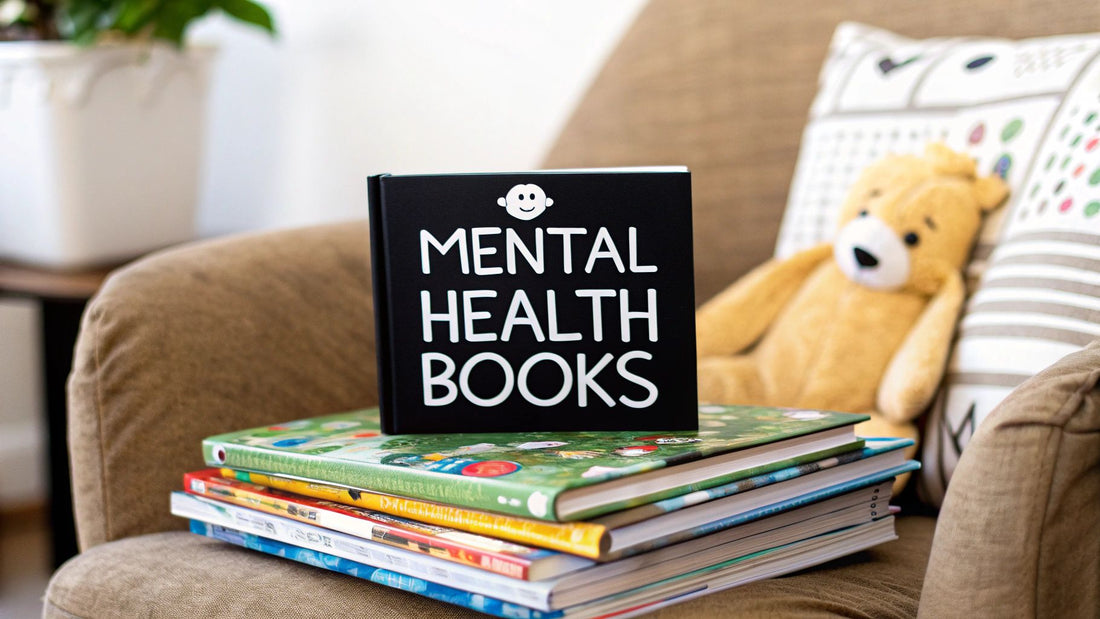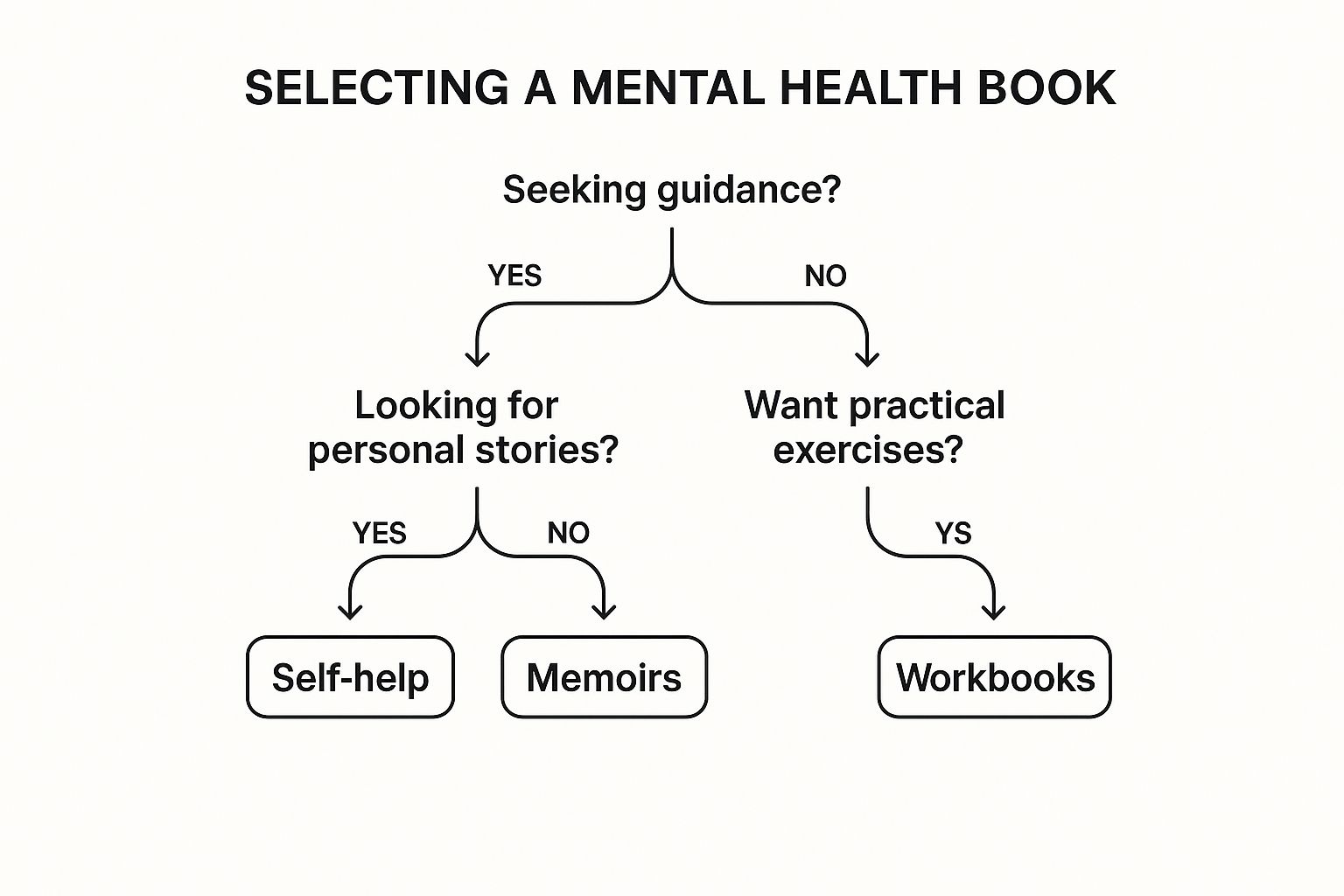
Discover the Best Mental Health Books for All Ages
Share
The very best mental health books for children are the ones that gently crack open the door to conversations about really complex emotions. Books like Ruby Finds a Worry by Tom Percival or Anna Llenas's The Colour Monster are perfect examples. They use simple, beautiful stories and illustrations to make big feelings like anxiety or confusion feel a whole lot less scary for little minds.
Why Children's Mental Health Books Matter Now More Than Ever

Our world feels like it's getting more complicated by the day, which makes talking about mental health from a young age more important than ever. For parents and carers, just figuring out how to start that conversation can feel like a huge hurdle. Addressing mental health openly is not just beneficial for our children's future; it has a significant impact on our communities and even the economy. Poor mental health costs UK businesses up to £56 billion a year, highlighting the urgent need to build resilience from childhood.
That's where books come in. They act as a gentle bridge, letting children explore all sorts of emotions through characters they can relate to, all within the safety of a story.
This isn't just a feeling; the numbers back it up. We’ve seen a huge increase in children's mental health books being published right here in the UK. This trend is a direct response to the growing challenges our kids are facing. Recent NHS data showed that a staggering one in five children aged 8 to 16 now has a probable mental health condition. That's a sharp rise from one in six just a few years ago.
A Gentle Introduction to Big Feelings
Stories are like mirrors. They help children see their own tangled feelings reflected in a character's journey. When a child reads about a character working through a "worry" or a moment of sadness, it makes their own experience feel valid. This is incredibly powerful and achieves a few key things:
- It builds their emotional vocabulary: Books give children the actual words to name what they’re feeling, like "anxious," "frustrated," or "lonely." A practical example is a child being able to say, "I feel like the Colour Monster today, all my colours are mixed up," instead of just having a tantrum.
- It normalises their feelings: Seeing that other people—even fictional characters—feel the same way helps them realise they aren't alone.
- It offers practical ideas: Stories often show simple coping strategies in action, like talking to a grown-up they trust or taking a few deep breaths.
This move towards more open conversations is happening everywhere, from what's being taught in schools to the rise of mental health apparel that uses positive messages to break down stigma. Books are a cornerstone of this wonderful movement. You can find out more about how a children's mental health book can help your child in our detailed guide.
An Important Disclaimer
While I believe wholeheartedly that these books are powerful tools for support and learning, it's really important to be clear about their role. I am not a mental health professional, and this guide is meant to be a helpful resource, not a replacement for proper professional advice.
If you are worried about your child’s wellbeing, please speak to your GP or a qualified mental health practitioner. Think of these books as the first step on a journey towards emotional literacy—a way to build a foundation for resilience and open communication.
How Stories Build Resilience in Young Minds

Stories are so much more than just a bit of fun before bedtime; they are powerful tools for building real mental strength and resilience in our children. Reading is an active, thoughtful process. It invites a child to stop, think, and feel right alongside a character. This creates a much-needed contrast to the fast-paced, often passive world of social media, which can sometimes chip away at a young person’s wellbeing by promoting comparison and unrealistic standards.
The very best mental health books work their magic in two key ways: they act as both a mirror and a window for the reader.
As a mirror, a story lets a child see their own feelings and struggles reflected in a character's journey. This validation is incredibly powerful, showing them that they are not alone in what they're going through.
As a window, a book offers a peek into someone else’s world entirely. This helps to build empathy and understanding, showing that everyone experiences life and its challenges in different ways. This dual role helps to shrink feelings of isolation and fosters a deep sense of connection with others.
Learning Through Narrative
When a child gets lost in a story about a character who hits a roadblock and finds a way to move past it, they are essentially learning problem-solving skills in a safe, imaginative space. They get to see resilience in action. A character might learn to manage their anger, ask a friend for help, or find the courage to try something new, providing a gentle blueprint for the child to use in their own life.
This process is about more than just finding neat solutions. It’s about understanding that difficult feelings are a normal part of being human and that it’s possible to navigate them. Research backs this up, too. A UK study found that young people aged 14 to 25 who identified as strong readers also reported higher levels of happiness. In fact, a remarkable 40% of these readers described themselves as ‘very happy,’ compared to just 21% of non-readers.
From Story to Action
The wonderful thing is that the lessons learned from a book don’t have to stay on the page. They can be woven into a child's daily life, strengthening their emotional toolkit one story at a time. To take this even further, you can pair these narratives with practical tools like dedicated growth mindset activities for kids.
By doing this, you can reinforce the positive messages found in books, helping children to develop a strong sense of self-belief and perseverance. Together, these stories and activities create a powerful foundation for lifelong emotional health.
Choosing the Right Book for Your Child's Needs
Picking out the perfect book to support your child’s mental health can feel like a pretty big job. With so many options out there, how do you find the one that will really click? The secret is to look past the pretty cover and think about a few simple things to make sure the story is a good fit for your child's age and unique personality.
Let’s be honest, the best mental health books are never one-size-fits-all. A book that a four-year-old loves for exploring big, new feelings will probably feel a bit simplistic for a ten-year-old trying to figure out tricky friendships. The whole point is to find a story that meets your child exactly where they are.
This little decision tree is a great starting point to help you figure out what kind of book might be most helpful right now.

As you can see, just clarifying what you’re looking for—whether it’s some gentle guidance, a relatable story, or a hands-on activity book—can point you in the right direction.
Matching the Book to Your Child
To choose with confidence, it helps to focus on three key things: age-appropriateness, the core message, and the general tone of the book. Get these right, and the whole reading experience becomes so much more powerful and, just as importantly, enjoyable.
-
For Younger Children (Ages 3-6): Simple is best. Look for books with bright, clear illustrations and a straightforward story. Books that turn emotions into characters, like The Colour Monster by Anna Llenas, are absolutely brilliant for this age. They give little ones a solid, visual way to understand feelings that can otherwise feel very abstract and confusing.
-
For Older Children (Ages 7-11): Now, they’re ready for a bit more complexity. Seek out books with characters they can see themselves in—kids who are dealing with recognisable things like friendship wobbles or feeling anxious about a school play. These stories do more than just entertain; they build empathy and often subtly teach practical ways to cope.
Getting this right is one of the most powerful things you can do to support your child's mental health. It transforms reading from just a quiet pastime into a proper tool for emotional discovery and growth.
Book Selection Checklist for Parents
This quick-reference guide is designed to help you evaluate mental health books for your child based on key developmental and thematic criteria. Whether you're in a bookshop or scrolling online, it’s a handy framework for making a great choice.
| Selection Criterion | What to Look For (Ages 3-6) | What to Look For (Ages 7-11) | Why It Matters |
|---|---|---|---|
| Theme & Message | Simple, clear concept (e.g., sadness is okay). Focus on naming and accepting one emotion at a time. | More nuanced themes (e.g., resilience, navigating friendships, anxiety). Characters model problem-solving. | The message must be understandable and relevant to the child's current emotional world to be effective. |
| Illustrations & Format | Bold, colourful, expressive images that carry the story. Sturdy board books or picture books. | Illustrations that add emotional depth. May include chapter books with fewer, but still impactful, images. | Visuals are a key part of the story, setting the tone and helping children decode emotions they can’t yet read. |
| Language & Tone | Repetitive, simple, and rhythmic language. Gentle, reassuring, and direct tone. | Relatable dialogue and internal thoughts. The tone should be validating and never patronising. | The book needs to speak to the child, not at them, creating a sense of trust and safety. |
Remember, the goal isn't to "fix" anything. It’s about opening a door to a conversation and creating a safe space for your child to explore their inner world without any pressure. A good book simply gives them the words and the permission to do so.
Keeping these simple ideas in your back pocket will help you confidently choose books that don’t just fill a space on the shelf, but truly nurture your child’s emotional wellbeing for years to come.
Our Curated List of the Best Mental Health Books
Trying to find the best mental health books amid the sea of children’s literature can feel a bit much. So, to make things a little easier, we’ve handpicked a few absolute gems that we believe gently and effectively support a child’s wellbeing. Each one offers a lovely way to start conversations, build emotional literacy, and just provide a bit of comfort.
It's important to say that while these books are brilliant resources, I'm not a mental health professional. If you have any serious concerns about your child’s mental health, the best first step is always to chat with your GP or another qualified practitioner.
For Younger Children (Ages 3-7)
For this age group, it’s all about clear, vibrant illustrations and simple, often repetitive, text. These elements are magic for making big, abstract ideas like feelings feel concrete and much easier for little minds to grasp.
-
The Colour Monster by Anna Llenas: An international bestseller, and for good reason—it’s a masterpiece of simplicity. The story follows a monster whose feelings are all jumbled up, represented by a tangle of colours. A little girl gently helps him sort his feelings into separate jars, teaching children how to name and separate emotions like happiness (yellow), sadness (blue), and anger (red). It’s a fantastic visual tool for building that early emotional vocabulary.
-
Ruby Finds a Worry by Tom Percival: This is a truly beautiful book about a happy girl named Ruby, whose world gets turned upside down when she finds a small Worry. The Worry starts small but soon grows, following her everywhere and stopping her from enjoying anything. The story captures that isolating feeling of anxiety perfectly, but it also offers a gentle solution. When Ruby meets a boy who also has a Worry, they find that talking about them makes them shrink. It’s such a powerful, yet simple, lesson in the importance of sharing what’s on your mind.
-
The Invisible String by Patrice Karst: A deeply comforting book that’s just perfect for children wrestling with separation anxiety, grief, or loneliness. It introduces the lovely idea that we are all connected to the people we love by an invisible string made of love. No matter where you are, the string can’t be broken. It offers a real, tangible sense of connection and security, even when you’re physically apart.
For Older Children (Ages 8-12)
As children get a bit older, they’re ready for more nuanced stories. They connect with relatable characters who are navigating the kinds of challenges they might be starting to recognise in their own lives, from social dynamics to self-esteem.
- What to Do When You Worry Too Much: A Kid's Guide to Overcoming Anxiety by Dawn Huebner: This one is less of a traditional storybook and more of an interactive guide, written by a clinical psychologist. Using wonderfully kid-friendly language and engaging illustrations, it explains what anxiety is and gives practical, cognitive-behavioural techniques to manage it. It’s all about empowering children, teaching them that they can be the boss of their worries by giving them exercises and tools they can actually use in real-life situations.
A key takeaway from books like this is that they provide children with actionable strategies. Instead of just identifying a feeling, they offer a toolkit for managing it, which is incredibly empowering for a child who feels overwhelmed.
Of course, this is just a starting point. There's a rich and growing world of stories out there designed to support young minds. For more ideas tailored to different needs and ages, you can explore our full list of children's books recommendations which we’re always updating. Every story is a new chance to connect and understand.
Practical Tips for Reading and Relaxation

The story itself is just the beginning. Think of the best mental health books as a starting point; turning reading time into a genuinely therapeutic experience is where the real magic happens. By weaving simple relaxation techniques into your reading routine, you can deepen a book's impact and help your child build emotional skills that will last a lifetime.
This little shift transforms reading from something passive into an active tool for wellbeing. It also sends a powerful message: their feelings are important and absolutely worthy of time and attention. One of the simplest ways to start is by creating a dedicated 'calm corner'—a cosy, quiet space in your home that your child comes to associate with peace and safety.
Creating a Relaxing Reading Ritual
The real goal here is to build positive feelings around reading and talking about emotions. A calm, inviting environment naturally helps a child lower their defences, making them much more open to the story’s message and any conversation that might follow. It’s a small ritual that can make a huge difference.
And it's not just about the book. You can introduce powerful, yet simple, strategies like specific breathing techniques for anxiety attacks to boost relaxation and mental wellbeing. Before you even open the book, why not try a simple 'box breathing' exercise together? Inhale for four counts, hold for four, exhale for four, and hold for four. It's a simple, rhythmic way to calm the nervous system.
Once the story is finished, the chat you have can be just as important as the book itself. The trick is to avoid direct questions that feel like a pop quiz. Instead, use gentle, open-ended prompts that invite them to share what’s on their mind.
A great book gives a child the vocabulary for their feelings; a gentle conversation gives them the confidence to use it. Your role isn't to have all the answers but to listen with curiosity and love.
Gentle Questions to Start a Conversation
Here are a few gentle questions you can adapt after reading together:
- "I wonder what it felt like to be [character's name] in that part of the story?"
- "Was there a part of the story that made you feel happy, or maybe a bit sad?"
- "What do you think was the bravest thing the character did?"
- "If you could give the character some advice, what would you say?"
These kinds of questions don't have a "right" answer. They simply open the door for your child to connect the story to their own life, if and when they feel ready. Nurturing this emotional literacy from a young age is a crucial investment. It not only helps the child but also ripples outwards, as emotionally resilient children grow into adults who are better equipped to handle life's challenges.
Your Questions About Children's Mental Health Books, Answered
Dipping your toes into the world of children's wellbeing can bring up all sorts of questions. It's a journey many of us are on, and we've put together this section to give you clear, straightforward answers to the queries we hear most often from parents and carers.
It's clear this is a topic on a lot of people's minds. A 2018 analysis showed a massive boom in the UK's mental health publishing world, with categories like 'Coping with Problems' and 'Psychology' growing by a huge 27%. It just goes to show how many of us are looking for good quality resources to help our kids. You can read more about this important publishing trend if you're curious.
When Should I Start Reading These Kinds of Books?
Honestly, you can start introducing books with themes of emotions and kindness from as early as two or three. Simple picture books about big feelings like sadness, anger, or happiness are brilliant for laying the foundations of emotional literacy.
As your child gets older, you can naturally progress to more complex stories that touch on things like anxiety or friendship troubles. The key is simply to match the book's message and complexity to where your child is at, developmentally. It’s never too early to start building that all-important emotional vocabulary.
What if My Child Doesn't Want to Talk About It?
That is completely, one hundred percent okay. It's so important not to push for a big discussion right away. The main goal here is to create a safe, warm experience where your child feels absolutely no pressure.
Sometimes, a story’s message sinks in quietly and a child will process it in their own time. You could just say something open and gentle, like, "That was a lovely story. I'm always here if you ever fancy a chat about it." Just the act of reading together is a powerful way to connect.
The value isn't always in the big conversation that happens right after you close the book. It's in planting a little seed of understanding and letting your child know you're a safe person to turn to when they're ready.
Are These Books a Substitute for Seeing a Doctor?
No, absolutely not. This is a really critical point we always want to make clear. Books are a wonderful, powerful tool for starting conversations, making feelings feel normal, and offering real comfort. They can be a fantastic part of a wider support system.
But they are never a replacement for professional medical advice or treatment. I am not a mental health professional. If you have any serious worries about your child's mental wellbeing, it's essential to speak with your GP, a school counsellor, or another qualified mental health expert to get the right support. If you are worried, a good first step is always to seek help from your doctor.
At Little Fish Books, we're truly passionate about creating stories and resources that support young minds on their journey. Come and explore our hand-picked collection of books, activities, and apparel, all designed to help nurture emotional wellbeing from a young age.
